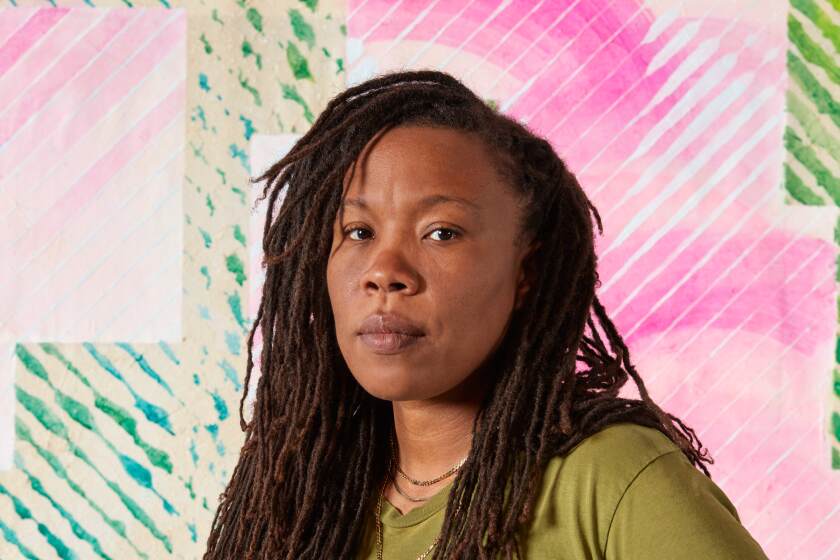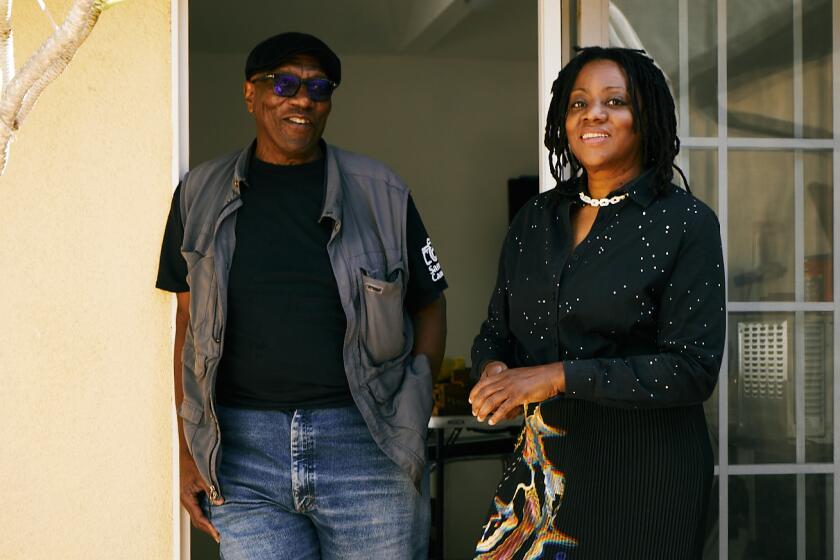- Share via

Maren Hassinger is teaching me how to twist newspaper. We’re sitting in the living room of her Harlem apartment, and the 76-year-old artist has taken a page of the New York Times and torn it into long, thin strips. She grasps one of them and begins to shape it, in a repetitive motion that falls somewhere between turning a key and twirling a strand of hair. “I start with my right hand,” she says. “It keeps going, and my left hand sort of confirms the twist.”
I take a strip and start twisting too, following Hassinger’s instructions and trying to mimic her movements. I don’t know if I’m doing it right, but the action feels oddly comfortable and comforting for something I’ve never done, or thought about doing, before.
“It’s so nice because you can have a full conversation; you don’t even have to look at your hands,” Hassinger says. She compares the process — which she’s used in sculptures and participatory performances — to a sewing bee. When we’ve both completed a couple strips, she shows me how to tie them together with a square knot. While I join my ends to form a kind of necklace, Hassinger riffs on what else the pieces could become when combined in different ways: curtains or a tube, or even, if you folded rather than twisted the paper, a woven grid. I’m struck by the possibilities she sees in such a quotidian material.
“Everybody thinks you have to be able to create a figure and put it on canvas or make it out of stone — that’s what an artist does,” she says. “But what an artist does is think about our human condition. That’s the job.”
In her new deeply personal body of work, the artist is planting the seeds of a narrative yet to be imagined.
Over the course of her almost 50-year career, Hassinger has done that time and again. She’s planted wire-rope trees along the side of a Los Angeles highway (“Twelve Trees,” 1979), scattered crumpled pink paper in New York City parks (“Pink Trash,” 1982), preserved redbud leaves and sewn them into a canopy (“Place of Bliss,” 2001), and painted her face black in ritual protest (“Daily Mask,” 2004). Whether she’s using sculpture, performance, or video (her preferred mediums), Hassinger creates abstracted, indelible images that evoke the bittersweet experience of being human.
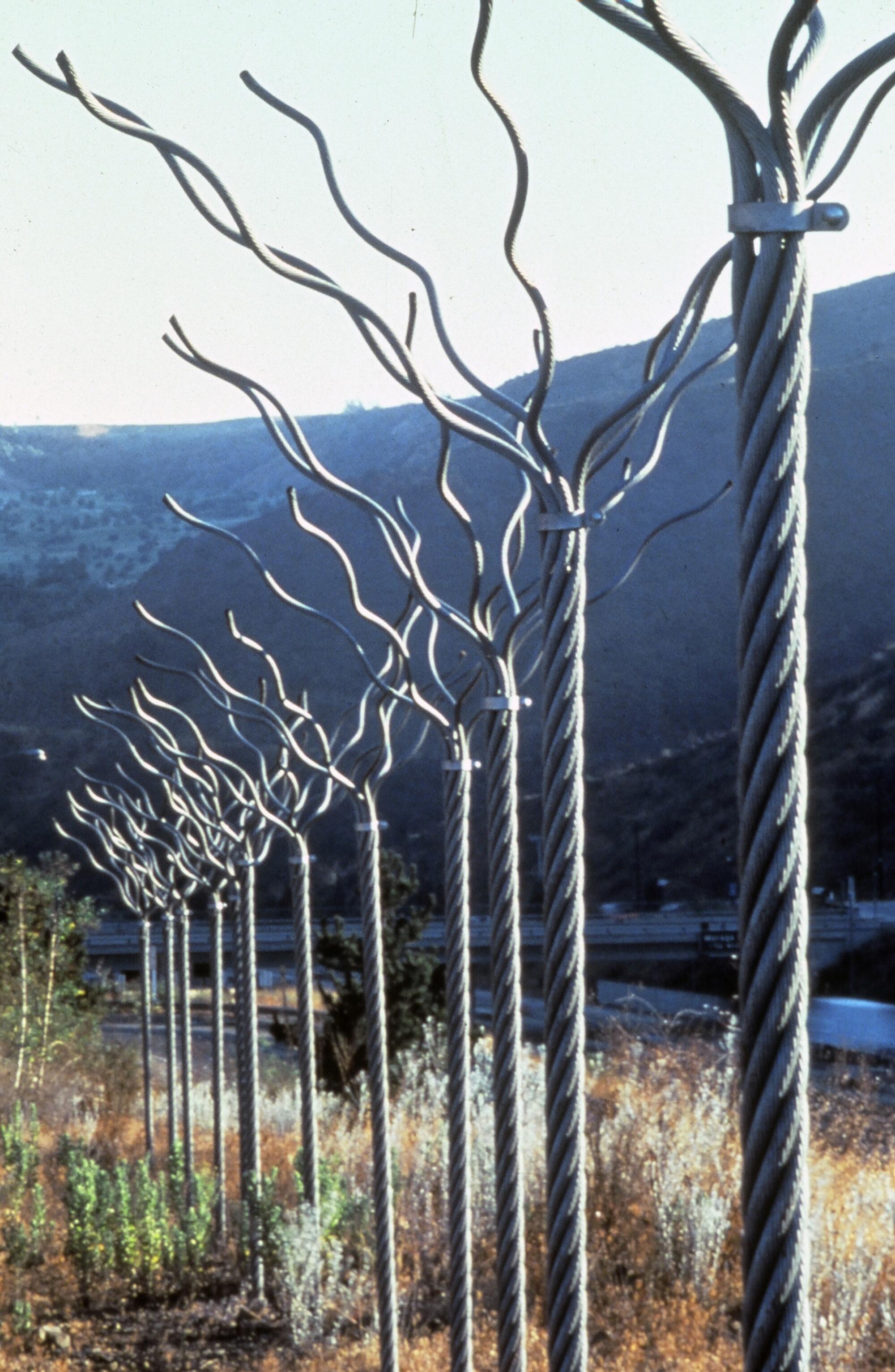


“The poetics of her practice is just magical,” says the artist Clifford Owens, who has researched and made work about the neglected history of African American performance art. When Owens was developing “Anthology” (2011–12), a project honoring that history, Hassinger was “one of the first people I reached out to, because the memory of her work was so strong.”
To leave such a profound impression is, in many ways, Hassinger’s goal. “Why am I making a field with steel reeds?” she asks rhetorically, referring to her many sculptures composed of waves of bent wire rope planted in concrete. “Because I love a field with wind. It’s beautiful, nourishing, encouraging.” But it would be futile, if not impossible, to try to re-create that field, so she makes a kind of cast of it, in the hopes that it will remind us to care for the real thing.
Hassinger is quick to note that she’s not an activist. And it’s true — her work doesn’t have an explicitly political or moral message. But she came of age amid the environmental movement of the 1960s, and nature has been her dominant subject since the 1970s. “I’ve always really been interested in the idea that we’re in a vanishing kind of nature and that I could make nature that commented on the decline,” she says. “It’s a document of the times we live in.”
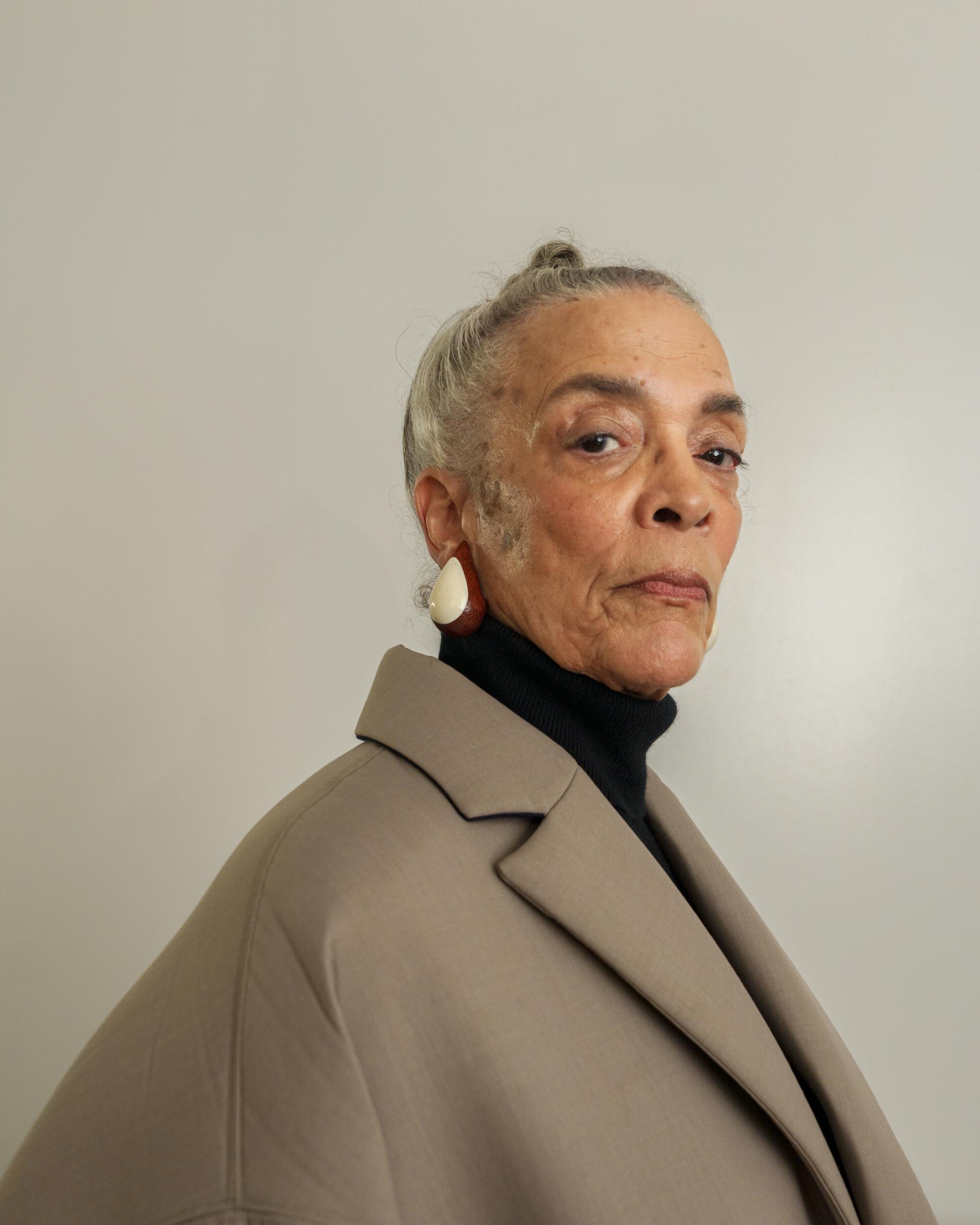
Those times have shifted: As the planet has gotten hotter, “climate change” has become a widespread term, and alarm bells about the future viability of the earth are ringing more urgently. Perhaps this is part of why the last decade has brought a revival of Hassinger’s work, including two retrospectives, new commissions and the acquisition of her archive by the Getty Research Institute. Yet on the whole, society continues to sideline the environment, treating it as a niche interest rather than a life-or-death concern. Sitting on her couch, looking out a big window that faces onto a small public park, Hassinger asks, “What else is there to think about? What’s solid and always there?”
Hassinger was born in Los Angeles to a mother who liked to arrange flowers and a father who was an architect. Her father was among the first Black architecture graduates from USC — an achievement whose importance he understood but wore lightly, and which made certain paths seem possible for his daughter. She would travel around the city with him to look at buildings, and his drafting table in the house, as well as his office full of people making drawings and plans, exerted an influence on her. “I think it’s partially genetic,” she muses, “my dad designing buildings and me designing sculptures.”
For the young Hassinger, though, dance was her favorite form of expression. In multiple published interviews, she’s told the story of taking her first class at around 5 years old and, at the end of the session, running across the floor in a red-and-white sundress and jumping over a stack of phone books. “I remember running, running, running, and jumping and how much fun it was, and how free it felt,” she recalled in a conversation with the curator Valerie Cassel Oliver, published in the catalog for her 2015 retrospective at the Spelman College Museum of Fine Art.
Artist Sable Elyse Smith draws on the sights and sounds and language of the carnival and the prison, revealing how deeply intertwined punishment is with entertainment and spectacle.
After years of classes and clubs, Hassinger went east to Bennington College in Vermont, where she hoped to major in dance. The department wouldn’t accept her, telling her she didn’t have the chops, so she majored in sculpture instead — a bitter disappointment that would also prove incredibly fortuitous. The mood at Bennington at the time was modernist: She found great support from the professor Isaac Witkin, a South African sculptor who’d studied in London with Anthony Caro, and had her final critique with the infamous Clement Greenberg. A photo of a work she made in 1969, the year of her graduation, shows an abstract configuration of geometric pieces of white-painted wood; it sits in the grass, with one beam jutting back at about 45 degrees — harbingers of tendencies in her art to come.
The situation at Bennington repeated itself almost exactly when Hassinger moved back to L.A. to attend graduate school. At UCLA, she hoped to study sculpture — only to be told by the department that she couldn’t. Once again, she had to rethink her plans, and once again, the obstacle proved beneficial. “Anytime somebody says no but you don’t stop is big,” she tells me. The artist Bernard Kester ran the school’s small weaving program; he not only accepted Hassinger but encouraged her experimentation. It was under his tutelage that she started working with her now-signature material, wire rope, which she discovered on a trip to a junkyard in search of inspiration and free materials.
“I found a piece of wire rope and realized it was like rope but steel — and in that sense, it was a derivation of fiber,” she says. “I brought that back, and Bernard was really excited about it.” The first work Hassinger made with it, “Interlock” (1972), features a length of the material bent into an oval, except at the bottom, the strands come apart and fray like live electrical wires. The ends do meet and interlock in their own way, but the process is messy and imperfect — it feels honest.
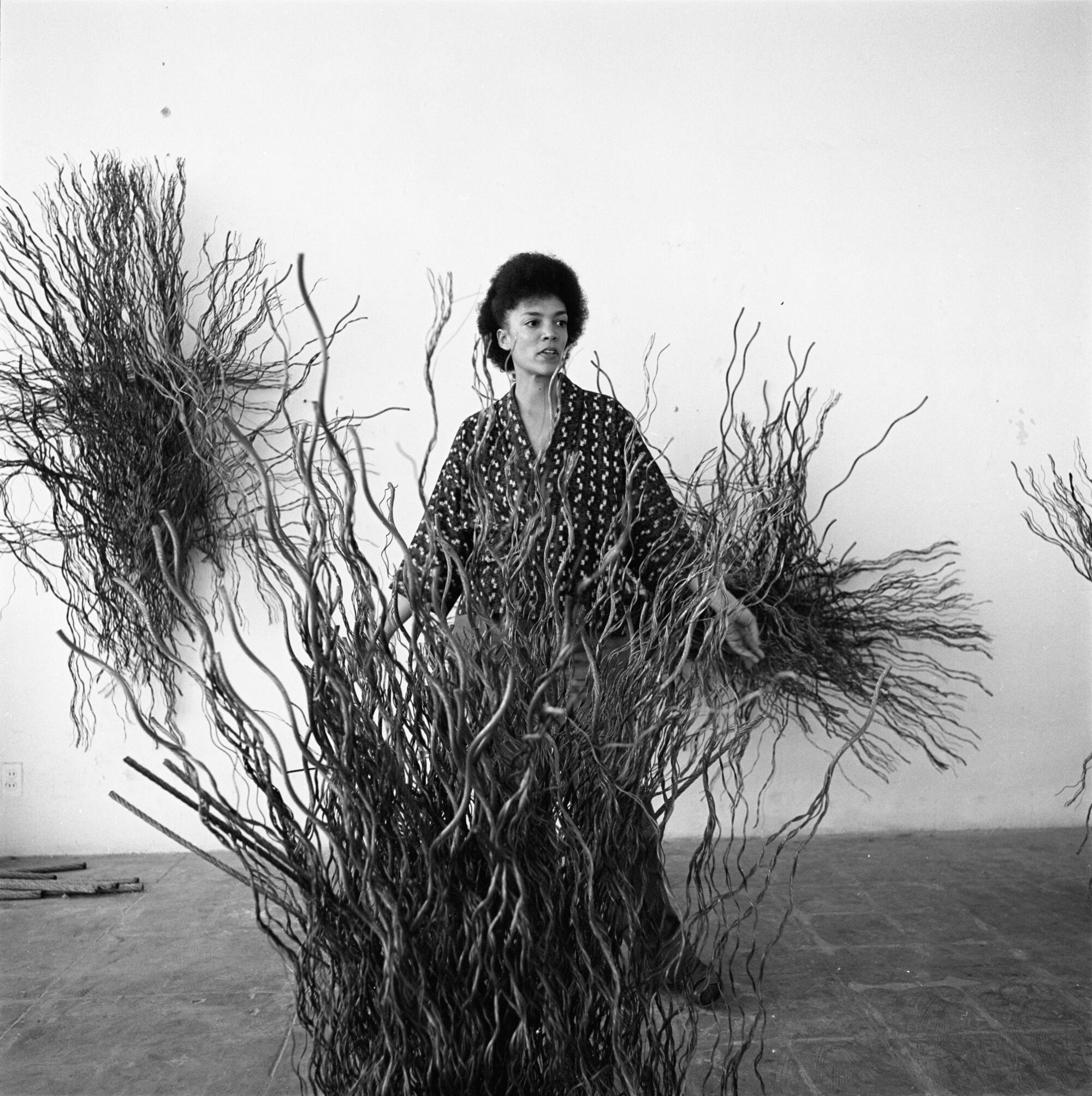
Hassinger graduated in 1973 with an MFA, and she was determined and committed to continue with her art. “When I got my degree, I actually did sit down and say, I am going to be an artist. I am an artist,” she recalls. “And after that, I was.”
L.A.’s art scene in the 1970s was fertile, experimental ground. Black artists like Noah Purifoy and Betye Saar were creating a new form of assemblage out of found materials, while feminists like Judy Chicago and Miriam Schapiro were reinvigorating media that had long been denigrated as women’s work. Both groups, as well as others, like Chicano artists, were making art that reflected the subjectivity of embodied experience and building their own networks and institutions in response to the racism and sexism of the mainstream. Hassinger’s work blossomed in this context.
Fulton Leroy “Mr. Wash” Washington is putting his story to the best use for the world.
She also embraced visual art’s turn to performance by not only making sculptures that implied motion, but also literally moving around them, incorporating her love of dance (she was still taking classes) into her work. In 1976, Hassinger held her first performance within an installation of her wire-rope pieces at the ARCO Center for Visual Art in downtown L.A. Titled “High Noon,” it was inspired by the western starring Gary Cooper and featured her and some friends moving around with fabric and branches to flamenco music; she’s described it as “transgressive, confrontational [and] improvised.”
Around this time, Hassinger met the artist Senga Nengudi, who would become her lifelong collaborator and friend. Nengudi was impressed by Hassinger’s exhibition at ARCO; as it turned out, the two had similar dance backgrounds and were both interested in using those backgrounds to activate their static work. Nengudi asked Hassinger if she would perform with some sculptures Nengudi had made out of pantyhose; Hassinger said yes.
“It was perfect,” Nengudi tells me, of watching her friend perform with her art for the first time. “The concept I had in my mind was people partnering in movement, like Fred Astaire and Ginger Rogers, where there’s a give-and-take related to what you’re going to do.” Hassinger, she says, “was willing to give in to the pieces and yield to them, and create improvisational movements. She’s responding to the materials, and the materials are responding back.”
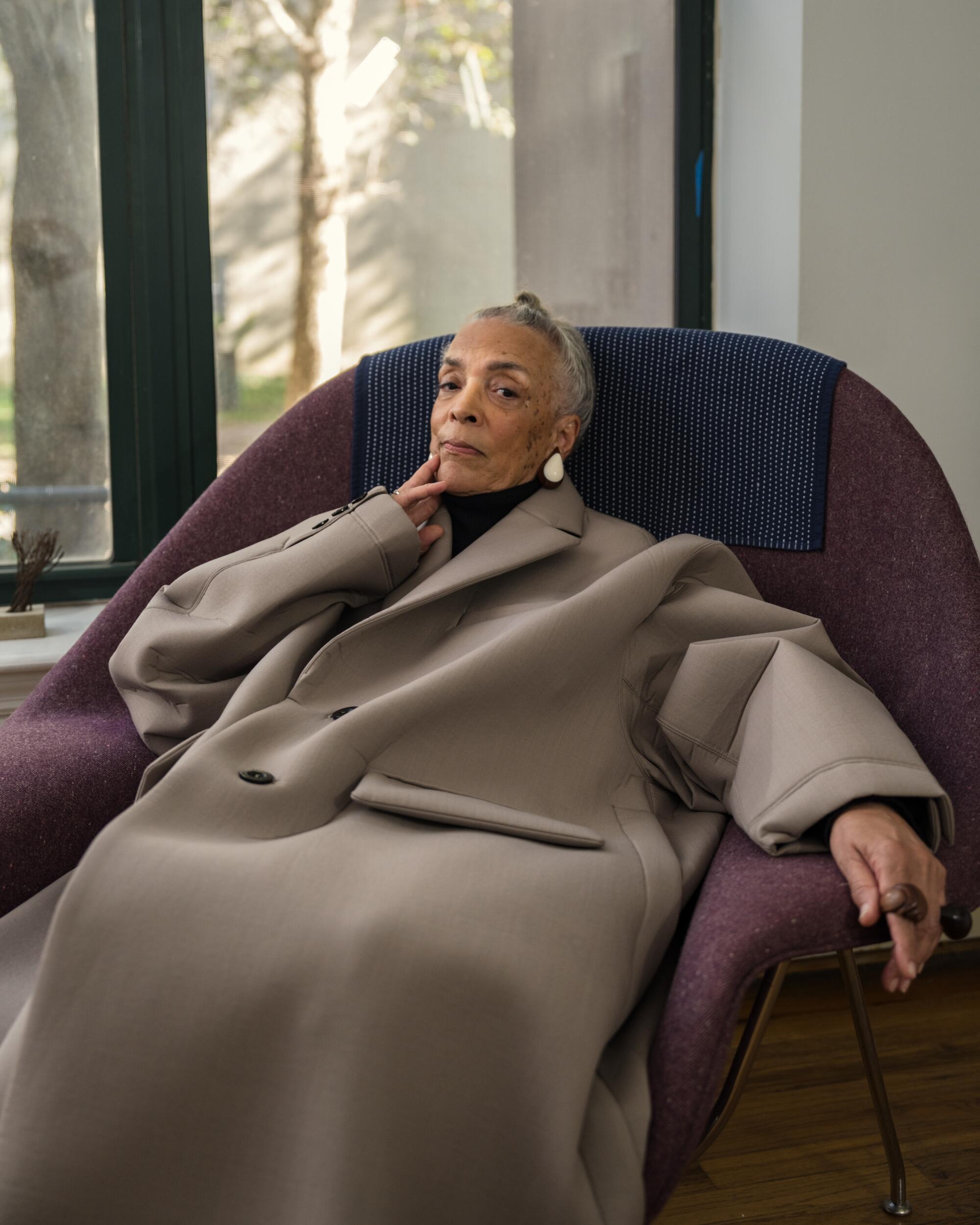
Hassinger and Nengudi’s partnership remains unique — and will be celebrated in upcoming exhibitions in Portland, Ore., and Valencia, Spain — but the two were part of a loose, larger group that included Franklin Parker, Houston Conwill, Ulysses Jenkins, and May Sun. These artists performed together in collaborations that in turn supported and inspired their individual practices. “It charged us up, so that we were able to go back to our studios and look at our work in new ways,” Nengudi recalls. “Friendship is friendship, but that was another layer: In essence, we spoke the same language.”
Despite the camaraderie and support in L.A., Hassinger began looking toward New York City, where the art market was stronger. She had her debut solo show there in 1980 at Just Above Midtown, a landmark gallery for avant-garde Black artists, followed the next year by a solo exhibition at the Los Angeles County Museum of Art — making her the first Black artist to do so. In 1984, she became an artist in residence at the Studio Museum in Harlem and moved across the country with her husband. Hassinger continued to create and show work over the following decade, often public art installations and performances, but lacked a dealer; meanwhile, she gave birth to two children, relocated to Long Island, then got divorced. In 1997, seeking a way to support herself and her kids, she became the director of the graduate school of sculpture at the Maryland Institute College of Art in Baltimore. She did that job for 20 years, but ultimately couldn’t stay away: While on a sabbatical in 2010, she moved back to Harlem.
When I arrive at Hassinger’s studio on an unseasonably warm October day, the artist greets me wearing a bright green T-shirt and hot pink pants — two colors, I note to myself, that have been significant in her practice — with her gray hair knotted in a bun. Moving around takes some effort now — she holds her back while descending or climbing stairs — but when I ask if she still dances, she admits that she likes to “twist and turn when nobody’s around.”
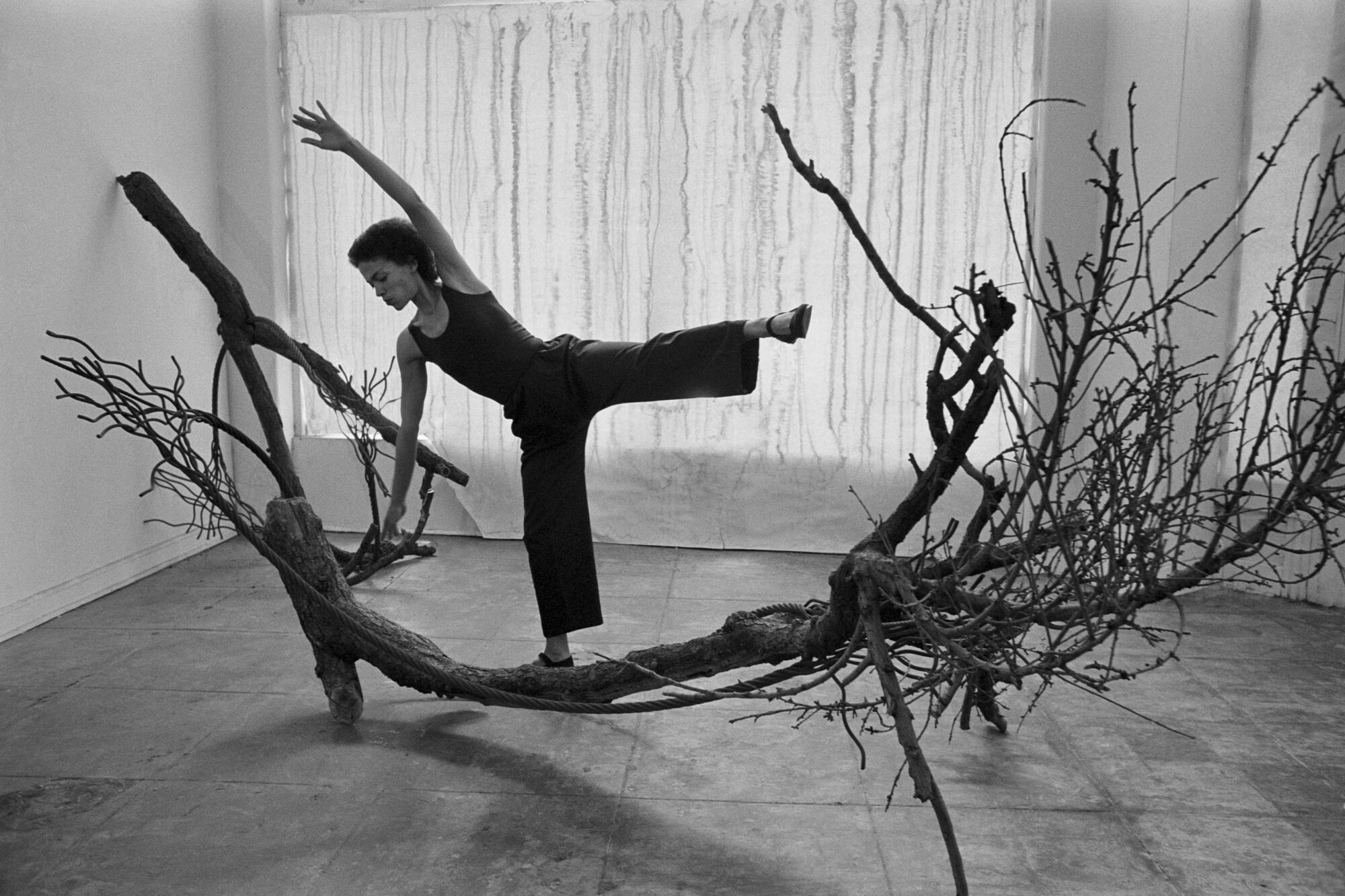
These days, Hassinger has two studio assistants, something that’s been enabled by her recent wave of mainstream success. This late-in-life momentum, which is all too common for women of color, began building around the mid-aughts, with her inclusion in several important museum exhibitions reexamining art movements and moments, including “Double Consciousness: Black Conceptual Art Since 1970,” “Now Dig This! Art and Black Los Angeles 1960–1980,” and “We Wanted a Revolution: Black Radical Women, 1965-85.” It continued with retrospectives of her work in 2015 and 2018 — the same year she joined the roster at Susan Inglett Gallery, giving her commercial representation (and allowing her to make real money from her art) for the first time. Just this fall, Hassinger has or will have work on view at the Art Institute of Chicago, the Nasher Sculpture Center, and Dia:Beacon; in L.A. she’s part of the forthcoming Black public art project Destination Crenshaw and has had her archive acquired by the Getty Research Institute, as part of its African American Art History Initiative.
“What did it mean to enter the art world in the late ’60s and ’70s as a Black woman, in a field that largely ignored the cultural production of Black women?” asks LeRonn P. Brooks, the curator of the Getty initiative and a friend of Hassinger. “Many Black women artists were making innovative work, but their voices were not included in terms of the criticism being written, the research being done, even group shows that purported to have the voices of women.
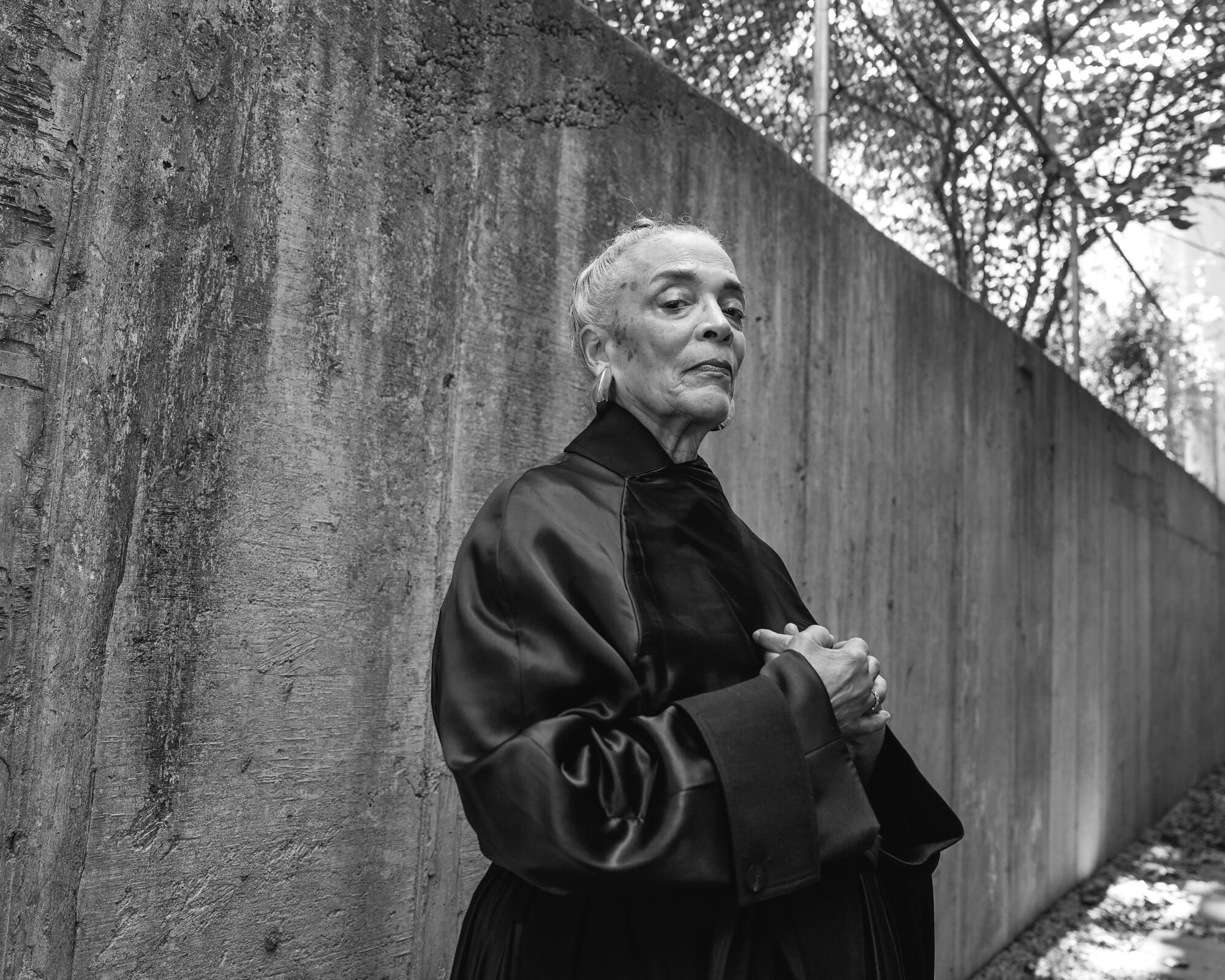
“A conversation with Maren, it’s a primer,” Brooks says. “It’s an orientation in what it means to have a real sense of persistence and fortitude.”
Perhaps because Hassinger is keenly aware of how her own persistence and fortitude have kept her going, she speaks about the newfound interest in her with a sense of humor. “It’s kind of like overnight successes in Hollywood: They’re always running around looking glamorous,” she says. “Well, I’m like the character actor who was in a lot of movies for a lot of years and finally got the Academy Award, but it’s no big thing,” she continues, breaking out into a boisterous laugh, which she does often. “They should’ve given me that 20 years ago — which is good, because it made me develop my thinking and craft about the importance of art in the community.”
L.A.’s rich cultural history is alive through the life and work of the city’s unofficial poet laureate. Just ask her brother George Evans.
Along the way, Hassinger experienced plenty of discrimination, but her approach has been to grapple with it obliquely, through art that touches on aspects of our common experience rather than emphasizing our points of difference. It’s why she’s conducted performers delivering soliloquies about social problems as an eccentric orchestra and installed videos of clouds in an airport. It’s why, for “Love” (2008), she created a concave pyramid of pink plastic shopping bags, each containing a note that read “love” and inflated with a person’s breath. The work cascaded down 32 feet from the ceiling like a waterfall at the Baltimore Museum of Art.
These aren’t gestures that blithely pretend we’re all the same; they’re spiritual offerings and appeals to something deep-seated and elemental. “It’s much easier to swallow poetry than pounding your fist or gavel on a podium,” Hassinger says. People often think if there’s something different about you, “you don’t have the same soul. But you do. I wish people would get it: We’re all human. We’re all here. We all share this. Be nice.”

Hair & Makeup: Mollie Gloss at Paradis using Oribe and Byredo
Styling Assistant: Ben Jastremski
Jillian Steinhauer writes about the politics of art and comics for publications like the New York Times, New York Magazine, the Nation and the New Republic. She is a winner of a 2023 Rabkin Prize.
